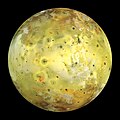File:Io highest resolution true color.jpg

Dimensioni di questa anteprima: 600 × 600 pixel. Altre risoluzioni: 240 × 240 pixel | 480 × 480 pixel | 768 × 768 pixel | 1 024 × 1 024 pixel | 2 048 × 2 048 pixel | 3 196 × 3 196 pixel.
File originale (3 196 × 3 196 pixel, dimensione del file: 1,88 MB, tipo MIME: image/jpeg)
Cronologia del file
Fare clic su un gruppo data/ora per vedere il file come si presentava nel momento indicato.
| Data/Ora | Miniatura | Dimensioni | Utente | Commento | |
|---|---|---|---|---|---|
| attuale | 08:00, 21 ago 2018 |  | 3 196 × 3 196 (1,88 MB) | The NMI User | Reverted to version as of 23:57, 14 July 2018 (UTC): Needs margins from Kaldari because the crops are too close on all sides in this photo. |
| 22:08, 20 ago 2018 |  | 2 796 × 2 796 (1,81 MB) | Jdx | Reverted to version as of 18:51, 9 May 2010 (UTC) | |
| 03:55, 6 ago 2018 |  | 3 196 × 3 196 (1,88 MB) | Jcpag2010 | Reverted to version as of 23:57, 14 July 2018 (UTC) | |
| 07:40, 2 ago 2018 |  | 2 796 × 2 796 (1,81 MB) | PlanetUser | Reverted to version as of 18:51, 9 May 2010 (UTC) | |
| 01:57, 15 lug 2018 |  | 3 196 × 3 196 (1,88 MB) | Kaldari | margins | |
| 02:42, 21 dic 2015 |  | 2 796 × 2 796 (1,81 MB) | PlanetUser | Reverted to version as of 18:51, 9 May 2010 (UTC) | |
| 21:09, 23 ott 2015 |  | 2 952 × 2 940 (1,8 MB) | Jacek Halicki | frame | |
| 20:51, 9 mag 2010 |  | 2 796 × 2 796 (1,81 MB) | Julia W | sorry, trying that again | |
| 20:35, 9 mag 2010 |  | 2 796 × 2 796 (5,2 MB) | Julia W | fresh conversion to jpeg from tiff, at higher quality | |
| 21:39, 23 apr 2006 |  | 2 796 × 2 796 (771 KB) | Uwe W. | Original Caption Released with Image: NASA's Galileo spacecraft acquired its highest resolution images of Jupiter's moon Io on 3 July 1999 during its closest pass to Io since orbit insertion in late 1995. This color mosaic uses the near-infrared, gr |
Voci che usano questa immagine
La seguente pagina usa questo file:
Utilizzo globale del file
Anche i seguenti wiki usano questo file:
- Usato nelle seguenti pagine di af.wikipedia.org:
- Usato nelle seguenti pagine di als.wikipedia.org:
- Usato nelle seguenti pagine di an.wikipedia.org:
- Usato nelle seguenti pagine di ar.wikipedia.org:
- كبريت
- بلوتو
- بوابة:علم الفلك/تصنيفات
- أقمار المشتري
- أقمار غاليليو
- آيو (قمر)
- قالب:المجموعة الشمسية
- قائمة أجرام المجموعة الشمسية مرتبة حسب الحجم
- قائمة أجرام النظام الشمسي المستديرة بالجاذبية
- قائمة الأقمار الطبيعية
- خط زمني لاكتشاف كواكب المجموعة الشمسية وأقمارها
- اكتشاف واستكشاف النظام الشمسي
- قائمة أنواع الكواكب
- بوابة:المجموعة الشمسية/هل تعلم/2
- مستخدم:ASammour/صور مختارة في الفارسية والتركية
- 1981 ميداس
- مرصد براكين آيو
- Usato nelle seguenti pagine di ary.wikipedia.org:
- Usato nelle seguenti pagine di arz.wikipedia.org:
- Usato nelle seguenti pagine di ast.wikipedia.org:
- Usato nelle seguenti pagine di azb.wikipedia.org:
- Usato nelle seguenti pagine di az.wikipedia.org:
- Usato nelle seguenti pagine di ba.wikipedia.org:
- Usato nelle seguenti pagine di be-tarask.wikipedia.org:
- Usato nelle seguenti pagine di be.wikipedia.org:
- Usato nelle seguenti pagine di bg.wikipedia.org:
- Usato nelle seguenti pagine di bh.wikipedia.org:
- Usato nelle seguenti pagine di bn.wikipedia.org:
Visualizza l'utilizzo globale di questo file.







